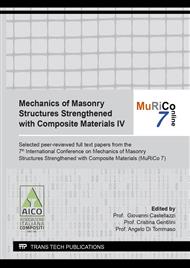[1]
A.S. Calabrese, T. D'Antino, C. Poggi, P. Colombi, G. Fava, M.A. Pisani, Application of externally bonded inorganic-matrix composites to existing masonry structures, Research for Development. (2020) 283–292. https://doi.org/10.1007/978-3-030-33687-5_25.
DOI: 10.1007/978-3-030-33687-5_25
Google Scholar
[2]
T. D'Antino, A.S. Calabrese, C. Poggi, P. Colombi, G. Fava, M. Bocciarelli, Strengthening of different types of slabs with composite-reinforced mortars (CRM), Research for Development. (2020) 293–303. https://doi.org/10.1007/978-3-030-33687-5_26.
DOI: 10.1007/978-3-030-33687-5_26
Google Scholar
[3]
C.G. Papanicolaou, T.C. Triantafillou, M. Papathanasiou, K. Karlos, Textile reinforced mortar (TRM) versus FRP as strengthening material of URM walls: out-of-plane cyclic loading, Mater Struct. 41 (2008) 143–157. https://doi.org/10.1617/s11527-007-9226-0.
DOI: 10.1617/s11527-007-9226-0
Google Scholar
[4]
T. D'Antino, F. Focacci, L.H. Sneed, C. Pellegrino, Shear strength model for RC beams with U-wrapped FRCM composites, J. Compos. Constr. 24 (2020). https://doi.org/10.1061/(ASCE)CC.1943-5614.0000986.
DOI: 10.1061/(asce)cc.1943-5614.0000986
Google Scholar
[5]
J. Donnini, G. Maracchini, S. Lenci, V. Corinaldesi, E. Quagliarini, TRM reinforced tuff and fired clay brick masonry: Experimental and analytical investigation on their in-plane and out-of-plane behavior, Construction and Building Materials. 272 (2021) 121643. https://doi.org/10.1016/j.conbuildmat.2020.121643.
DOI: 10.1016/j.conbuildmat.2020.121643
Google Scholar
[6]
G. de Felice, S. De Santis, L. Garmendia, B. Ghiassi, P. Larrinaga, P.B. Lourenço, D.V. Oliveira, F. Paolacci, C.G. Papanicolaou, Mortar-based systems for externally bonded strengthening of masonry, Mater Struct. 47 (2014) 2021–2037. https://doi.org/10.1617/s11527-014-0360-1.
DOI: 10.1617/s11527-014-0360-1
Google Scholar
[7]
G. Crisci, F. Ceroni, G.P. Lignola, Efficiency of FRCM systems for strengthening of masonry walls, AIP Conference Proceedings. 2293 (2020) 240008. https://doi.org/10.1063/5.0026446.
DOI: 10.1063/5.0026446
Google Scholar
[8]
F. Ceroni, R. Cuzzilla, M. Pecce, Assessment of performance of steel and GFRP bars as injected anchors in masonry walls, Construction and Building Materials. 123 (2016) 78–98. https://doi.org/10.1016/j.conbuildmat.2016.06.124.
DOI: 10.1016/j.conbuildmat.2016.06.124
Google Scholar
[9]
F.G. Carozzi, P. Colombi, G. Fava, C. Poggi, Mechanical and bond properties of FRP anchor spikes in concrete and masonry blocks, Composite Structures. 183 (2018) 185–198. https://doi.org/10.1016/j.compstruct.2017.02.026.
DOI: 10.1016/j.compstruct.2017.02.026
Google Scholar
[10]
Z.R. Aljazaeri, M.A. Janke, J.J. Myers, A novel and effective anchorage system for enhancing the flexural capacity of RC beams strengthened with FRCM composites, Composite Structures. 210 (2019) 20–28. https://doi.org/10.1016/j.compstruct.2018.10.110.
DOI: 10.1016/j.compstruct.2018.10.110
Google Scholar
[11]
Sika Italia SpA, SikaWrap® Anchor G Technical Sheet. April 2021, (2021).
Google Scholar
[12]
Sika Italia SpA, Sikadur®-52 Injection Normal Technical Sheet. March 2020, (2020).
Google Scholar
[13]
Fornaci Laterizi Danesi SpA, DM116 Technical Sheet, (2021).
Google Scholar
[14]
Consiglio Nazionale delle Ricerche, Istruzioni per la Progettazione, l'Esecuzione ed il Controllo di Strutture di Calcestruzzo Armato con barre di Materiale Composito Fibrorinforzato. CNR-DT 203/2006, CNR, Rome, Italy, (2007).
DOI: 10.1007/88-470-0454-3_12
Google Scholar
[15]
CSLLPP - Servizio Tecnico Centrale, Linea Guida per la identificazione, la qualificazione ed il controllo di accettazione dei sistemi a rete preformata in materiali compositi fibrorinforzati a matrice polimerica da utilizzarsi per il consolidamento strutturale di costruzioni esistenti con la tecnica dell'intonaco armato CRM (Composite Reinforced Mortar), Rome, Italy, (2019).
DOI: 10.3221/igf-esis.12.04
Google Scholar
[16]
Sika Italia SpA, Sika AnchorFix®-3001 Technical Sheet. January 2021, (2021).
Google Scholar
[17]
C. Carloni, F. Focacci, FRP-masonry interfacial debonding: An energy balance approach to determine the influence of the mortar joints, European Journal of Mechanics, A/Solids. 55 (2016) 122–133. https://doi.org/10.1016/j.euromechsol.2015.08.003.
DOI: 10.1016/j.euromechsol.2015.08.003
Google Scholar
[18]
V.C. Li, Y. Wang, S. Backer, Effect of inclining angle, bundling and surface treatment on synthetic fibre pull-out from a cement matrix, Composites. 21 (1990) 132–140. https://doi.org/10.1016/0010-4361(90)90005-H.
DOI: 10.1016/0010-4361(90)90005-h
Google Scholar
[19]
A.S. Calabrese, T. D'Antino, P. Colombi, C. Poggi, Study of the influence of interface normal stresses on the bond behavior of FRCM composites using direct shear and modified beam tests, Construction and Building Materials. 262 (2020). https://doi.org/10.1016/j.conbuildmat.2020.120029.
DOI: 10.1016/j.conbuildmat.2020.120029
Google Scholar
[20]
A.S. Calabrese, T. D'Antino, P. Colombi, Experimental and analytical investigation of PBO FRCM-concrete bond behavior using direct and indirect shear test set-ups, Composite Structures. 267 (2021). https://doi.org/10.1016/j.compstruct.2021.113672.
DOI: 10.1016/j.compstruct.2021.113672
Google Scholar
[21]
A.S. Calabrese, T. D'Antino, P. Colombi, C. Poggi, C. Carloni, Influence of the test set-up on the bond behavior of FRCM composites, ACI SP. 345 (2021) 185–195.
Google Scholar


